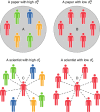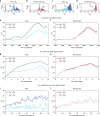The preeminence of ethnic diversity in scientific collaboration
- PMID: 30514841
- PMCID: PMC6279741
- DOI: 10.1038/s41467-018-07634-8
The preeminence of ethnic diversity in scientific collaboration
Abstract
Inspired by the social and economic benefits of diversity, we analyze over 9 million papers and 6 million scientists to study the relationship between research impact and five classes of diversity: ethnicity, discipline, gender, affiliation, and academic age. Using randomized baseline models, we establish the presence of homophily in ethnicity, gender and affiliation. We then study the effect of diversity on scientific impact, as reflected in citations. Remarkably, of the classes considered, ethnic diversity had the strongest correlation with scientific impact. To further isolate the effects of ethnic diversity, we used randomized baseline models and again found a clear link between diversity and impact. To further support these findings, we use coarsened exact matching to compare the scientific impact of ethnically diverse papers and scientists with closely-matched control groups. Here, we find that ethnic diversity resulted in an impact gain of 10.63% for papers, and 47.67% for scientists.
Conflict of interest statement
The authors declare no competing interests.
Figures





References
-
- Page, S. E. The Difference: How the Power of Diversity Creates Better Groups, Firms, Schools, and Societies (Princeton University Press, Princeton, 2008).
-
- Ager P, Brückner M. Cultural diversity and economic growth: evidence from the US during the age of mass migration. Eur. Econ. Rev. 2013;64:76–97. doi: 10.1016/j.euroecorev.2013.07.011. - DOI
-
- Lee N. Migrant and ethnic diversity, cities and innovation: firm effects or city effects? J. Econ. Geogr. 2014;15:769–796. doi: 10.1093/jeg/lbu032. - DOI
MeSH terms
LinkOut - more resources
Full Text Sources

